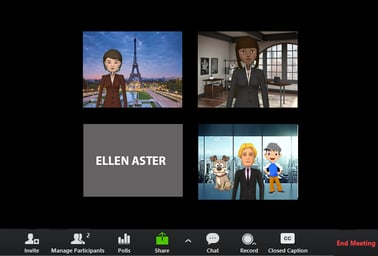As everyone adjusts to the new normal of remote living, working, and learning, it’s easy to make  observations on the differences we are experiencing between today and what was before the pandemic. As we trudge through the fourth week of the quarantine and all of our business interactions are through a video conferencing platform, one of the many observations I’ve had is how people show up in ZOOM and how that style equates to their DiSC style.
observations on the differences we are experiencing between today and what was before the pandemic. As we trudge through the fourth week of the quarantine and all of our business interactions are through a video conferencing platform, one of the many observations I’ve had is how people show up in ZOOM and how that style equates to their DiSC style.
If I’ve lost you, let me explain…
I have observed four different and unique types of ZOOM behaviors as follows:
The Multi-Tasker
This is the person who just can’t help themselves; they must multitask and get three things done at once no matter what they are doing or no matter how disruptive it can be. The telltale sign of the multitasker is they greet you with a warm hello to seduce you into thinking you will have their attention. But, as soon as the session starts, they put themselves on mute. Now, watch their eyes. At first, they are looking right into the camera. Maybe they nod their head once in a while and may they make some sort of facial expression. But what’s really happening is they are looking at their other work and multitasking. After about 15 minutes when your session really gets going, they will very subtly turn off their camera so they are in “listen-only” mode to your session while they are off doing at least two other tasks.
The World Traveler
This is the person who makes you dizzy by constantly switching their background pictures. First, it’s San Francisco, because that is one of the default backgrounds ZOOM provides. But then when they figure out you can make your own backgrounds, it’s like they are on a starship moving at warp speed to Shanghai, New York, Paris, back to San Francisco, and then to the Brady house in Southern California.
The Child / Pet Star
This is the person who is making a star out of their child or pet. It starts out innocently enough, as you see the child walk into the scene or the family dog scamper by. But then they have to pause the meeting to take care of said child/pet or perhaps even to feed it. Your session is put on hold for a few minutes but then, after things start up, the new star of the show is back wanting to see what Mommy or Daddy is up to on that cool computer with all those funny people talking about projects and trying to get some work done.
Hyperintensity
This is the person who is hanging on every word you say and examining every pixel of every page that you are sharing or discussing on the screen. They incessantly nod their heads, squinch their eyes, and furrow their brows while over exaggerating their interest in what you are sharing. It’s like there are literally coming through your screen to check out your work because they are so interested in it.
So, here’s the fun part! I think there are direct parallels between these observable ZOOM behavior types and DiSC, the personality indicator tool.
Consider this…
“D” behavior is the Dominant style. Very aggressive, very confident, very curious and always wanting to get things done. This is your ZOOM multitasker.
The “I” behavior is the influencer style. Very enthusiastic, very collaborative, and a social butterfly loving to network and travel. This is your ZOOM world traveler.
The “S” behavior is the steady style. This style doesn’t want the attention and dislikes confrontation. The S style is often uncomfortable is social settings where you are meeting new people for the first time. This is your ZOOM child/pet star who’s putting others in front of the camera and taking the attention off themselves.
The “C” behavior is conscientiousness style. They have a deep attention to detail and has a deep level of distrust that can only be overcome by gathering data and understanding all the answers. This is your ZOOM hyper intensive style that is staring into your soul through the computer seeking all the details.
One of the ways this observation can be used effectively is to identify the people who are on your next ZOOM and then map out a strategy so you can play into their style to influence results!




